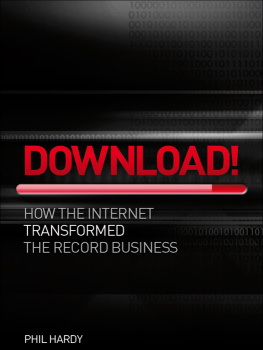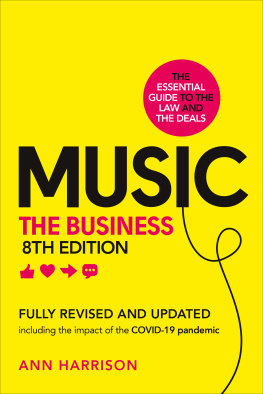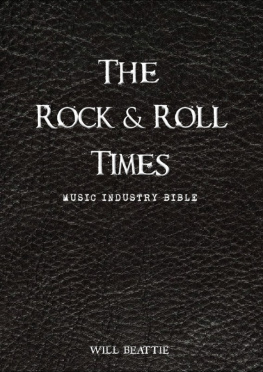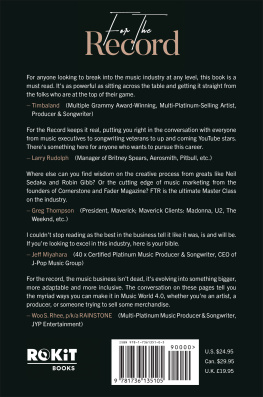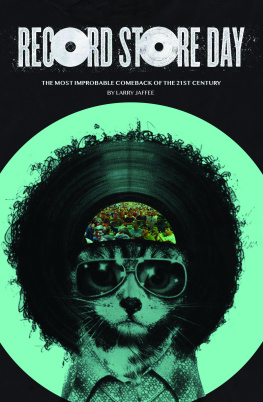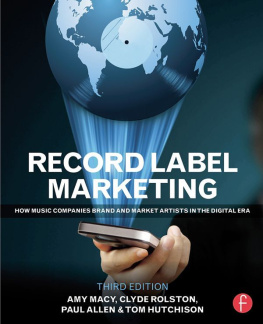To Dave Laing
Dave and I have collaborated and argued for some 40 years over a wide range of projects. Whether I was writing about Doug Sahm or the music industry, he has always been my first port of call.
Thank you Dave.
Copyright 2012 Omnibus Press
This edition 2012 Omnibus Press
(A Division of Music Sales Limited, 14-15 Berners Street, London W1T 3LJ)
Cover designed by Fresh Lemon
EISBN: 978-0-85712-803-4
The Author hereby asserts his / her right to be identified as the author of this work in accordance with Sections 77 to 78 of the Copyright, Designs and Patents Act 1988.
All rights reserved. No part of this book may be reproduced in any form or by any electronic or mechanical means, including information storage and retrieval systems, without permission in writing from the publisher, except by a reviewer who may quote brief passages.
Every effort has been made to trace the copyright holders of the photographs in this book, but one or two were unreachable. We would be grateful if the photographers concerned would contact us.
A catalogue record of this book is available from the British Library.
For all your musical needs including instruments, sheet music and accessories, visit www.musicroom.com
For on-demand sheet music straight to your home printer, visit www.sheetmusicdirect.com
Acknowledgements
T his book owes its existence to ASCAPs seat planner for the awards ceremony it mounted in London in 2011. I was seated beside the COO of the Music Sales Group Chris Butler and in the course of the ceremony after talking of matters East Anglian we discussed the current state of the music industry. I told him I was writing a book about such and he invited me to submit it to Omnibus, the book publishing division of Music Sales. Here it is.
In writing my book I relied extensively on Music & Copyright, the newsletter I and Dave Laing set up in partnership with the Financial Times in 1992 and the online newsletter theviewfromtheboundary I created in 2009. The contributors to these, notably James Bourne, Dave Laing, John Qualen and Gary von Zuylen, have helped enormously. I have also leant heavily on US and UK trade papers, Billboard and Music Week. Recent years have also seen the emergence of a number of websites and online newsletters devoted to the music industry. The chief ones of these that I have used are Hits Daily Double, Digital Music News and Music Void. I have also been lucky to have been advised by a variety of industry players, some of whom have spoken to me on the record and many who have spoken about industry practices and policies off the record. The bibliography further details the books, magazines and articles that helped me make sense of the issues. These represent the usual suspects.
I have also made extensive use of information provided by the International Federation of the Phonogram Industry (IFPI), the global trade body of the record industry. In particular I have relied on its annually published Recording Industry in Numbers (RIN), which is the best and most detailed statistical survey of the record industry. Unless stated otherwise all recorded music statistics are from RIN with the dollar equivalents converted at the appropriate historical rate. I have also used the yearbooks and/or reports of various national record industry, such as the BPI (UK) and the RIAJ (Japan). The global market shares quoted are those published by IFPI between 2000 and 2004. All other market shares, except those for the US which are from Nielsen SoundScan, were calculated by me at Music & Copyright and theviewfromtheboundary.
Once a book becomes more than an idea to make the jump to reality it needs help. Here I must thank my agents Michael Sissons and Fiona Petherham at PDF. Michael poured cold water on ideas at appropriate moments and Fiona was encouraging at (different) appropriate moments. Thank you. Chris Charlesworth sheparded the book into production, polishing here and there. Thank you And then theres my family: Thank you Emily, Joe and Steph.
Beginnings
S itting at his desk Eric Nicoli, the chairman and chief executive of the EMI Group, brushed a chocolate crumb from his chin. If the phone call he was about to make was successful, EMI would jump from being the fourth to the third largest music company in the world with strong prospects of becoming the second. Outside, it was a surprisingly mild spring day; inside the office the atmosphere was electric. As the clock ticked down to 14.30, Nicolis assistants and advisors shuffled their papers waiting for the phones pprppp. When it came, Nicoli paused and then decisively pressed the button on the intercom, waited for the crackle to fade, breathed deeply, paused again and began his sales pitch: Good morning Edgar..
Whoa
This is neither the story nor the style of Download.
Download chronicles of the making of the new record industry, from the boom years of the CD revolution of the late 1980s to the crisis of the present day, with particular stress on the last decade. As such it follows the actions and reactions of the major international record companies, five at the beginning of the story, now three, as they trudged their way through the digital slough of despond, bewildered by the fleet of foot digital innovators far more responsive to the changing marketing conditions through which (recorded) music was consumed and valued.
Download has no substantial heroes or villains, no individual or group who shaped the transformation that the industry is undergoing. Books have been written in which captains and swashbucklers of industry fight the good fight, in the course of which character flaws and strengths are uncovered, the hero finds victory (or defeat) and the reader is given an insight into how a particular area of human activity is structured and its problems are exposed.
Characters lie at the heart of such books. The record and related industries have within it characters enough. Some of these, Edgar Bronfman Jnr., Ahmet Ertegun, David Geffen, and Eric Nicoli, are known to the public. Others, Lyor Cohen, Zach Horowitz, Doug Morris and Mo Ostin, are less well known. But these characters, however powerful they may be, particularly within their companies, have been powerless to halt the loss of control that has been the key fact in the recent history of the music business. Recent years have also thrown up a new set of characters, Apples Steve Jobs, for whom music was a way to reinvigorate a faltering computer company, and Terra Firmas Guy Hands and Access Industries Len Blavatnik, venture capitalists bent on finding new ways of monetizing recorded music. These all have their significant place in my story, but the real story Dowload tells is the structural change that has, almost surreptitiously, taken place, within the music business. This change, for reasons I explain in detail, has left the captains of the record industry as unable to act as they were unwilling to act. In effect they became mere, but very well paid, observers of the shrinking of their domains.
Digital has been the elephant in the room, the palpable but difficult to understand presence that has affected everything it has come into contact with. Book publishing, film, music and the newspaper business, to name but a few are industries currently undergoing radical transformations because of it. Once information and intellectual content morphed from the analogue to the digital and became a series of bits and bytes, change was the name of the game of the businesses they inhabited. Hence the shift from DVDs to film (and television) on demand, from books bought at Borders or Waterstones to e-books from Amazon, from newspapers to news and comment available on the Internet.

